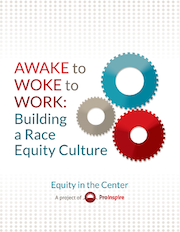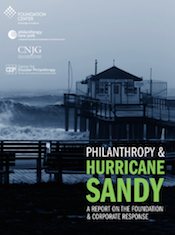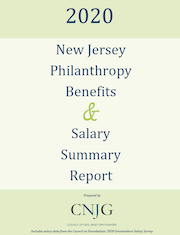Site Search
- resource provided by the Forum Network Knowledgebase.
Search Tip: Search with " " to find exact matches.
From the Commonfund, these white papers on investment policy statements, spending policy, board governance and risk tolerance, together with their most recent studies of investments at private and community foundations, operating charities and nonprofit healthcare organizations are made available though CNJG's Investment Forum for Foundations and Endowments.
Directors & Officers liability insurance provides financial protection for a foundation and its directors, officers, employees, and volunteers in the event of a lawsuit. CNJG offers its members the D&O liability insurance program provided through Aon Association Services, underwritten by The Hartford and endorsed by the United Philanthropy Forum. A discount is available to foundations with current membership with CNJG.
Fiduciary Liability and other coverage is also available to members at a discounted rate. Coverage is available in all states. Brokers can access the Forum’s D&O program through Aon Association Services.
Learn more using the documents below, on the Aon website or by contacting Jason Tharpe, program administrator at Aon Affinity, at 202-429-8561. To obtain the discount, foundations should let Aon know they are a member of CNJG, a member of the United Philanthropy Forum.
President Obama's Hurricane Sandy Task Force released this rebuilding strategy to serve as a model for communities across the nation facing greater risks from extreme weather and to continue helping the Sandy-affected region rebuild. The Rebuilding Strategy contains 69 policy recommendations, many of which have already been adopted, that will help homeowners stay in and repair their homes, strengthen small businesses and revitalize local economies and ensure entire communities are better able to withstand and recover from future storms.
A CNJG member queried our listserves for sample questions (not included in the grant application) you might ask grantees or potential grantees during site visits. CNJG compiled these responses, and other documents members use.
The Ford Institute for Community Building, a program of The Ford Family Foundation, works to help community leaders learn how to implement local solutions based on principles of effective community building. This paper describes the development and work of the The Ford Institute for Community Building.

Achieving race equity — the condition where one’s racial identity has no influence on how one fares in society — is a fundamental element of social change across every issue area in the social sector. Yet the structural racism that endures in U.S. society, deeply rooted in our nation’s history and perpetuated through racist policies, practices, attitudes, and cultural messages, prevents us from attaining it. The impact of structural racism is evident not only in societal outcomes, but in the very institutions that seek to positively impact them
In a sector focused on improving social outcomes across a wide range of issues, we need only look within our own organizations to understand why we have not yet achieved the depth of change we seek. Throughout the social sector, there remains a glaring omission of a fundamental element of social impact: race equity. While issue-specific dynamics play an important role in driving social impact (e.g., public policy around affordable housing or the elimination of food deserts to create access to nutritious foods), the thread of structural racism runs through almost every issue faced by the U.S. social sector. Race equity must be centered as a core goal of social impact across the sector in order to achieve our true potential and fulfill our organizational missions.
A CNJG corporate member asked for help with the scenario in which a corporate policy of not supporting religious organizations in their grantmaking, causes problems helping during a disaster in an urban or rural area, when the program that is delivering the disaster relief is based within a church. They want to work with those programs (a church serves as the program’s fiscal sponsor) who support efforts for hunger, homelessness, substance abuse recovery, racial equity, etc. as long as they do not discriminate and do no limit it to their own congregations. The request for policy samples to work around this religious organization hurdle as long as there is no discrimination or funding the actual church’s worship, was compelled by CNJG staff and is listed here.

Food is essential. But how often do you consider where your food comes from?This issue of What Funders Need to Know from the Washington Regional Association of Grantmakers explores the stages of the food system, from production all the way to disposal. Why is this important to philanthropy?
Because hunger, food insecurity, nutrition-related chronic disease, the health of resource lands and waterways, wages, and equal opportunity in the food economy all converge in our regional food system.
This paper explores community democracy as a cultural choice and a potential organizing system for philanthropy using stories that demonstrate its principles and practices, primarily growing from the experience of northern California communities. This experience offers a framework of principles and a beginning set of conclusions about how philanthropy can develop productive partnerships from the perspective of a place-based, community democracy.

This new report from CNJG and partners examines the response of foundations, corporations, and other institutional donors to the devastation wrought by Hurricane Sandy in October 2012. Numbering nearly 600, these funders have so far committed more than $380 million for relief, recovery and building efforts. The hard data and reflective observations in the report contribute to the growing body of knowledge that helps foundations and corporations be strategic and effective with their giving when disaster strikes.
Two years after the historic storm, Philanthropy & Hurricane Sandy: A Report on the Foundation & Corporate Response breaks down the allocation of dollars contributed thus far and offers perspective on the role of private giving in disaster response and lessons to be taken from this one. The report was published by the Foundation Center in partnership with the Council of New Jersey Grantmakers and Philanthropy New York, and with support from the Center for Disaster Philanthropy.
“Throughout the past two years, our exceptional nonprofit and funder community has taken on challenges they never imagined,” said Nina Stack, president of the Council of New Jersey Grantmakers. “These organizations continue to develop innovative solutions that other communities will learn from and build upon in future disasters.”
In addition to the report’s numerous funders, CNJG wishes to thank the PSEG Foundation for supporting this project.
Sample disaster preparedness and recovery plans for foundations.

